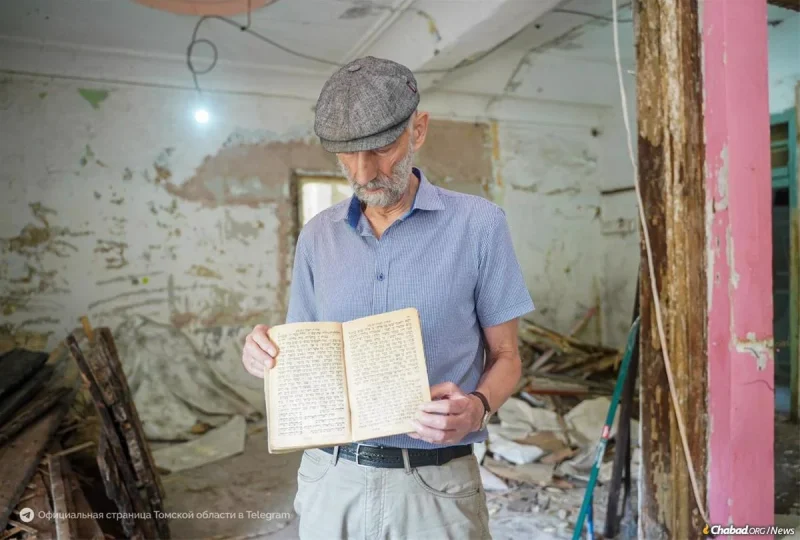
Century-Old ‘Siddur’ Discovered During Restoration of Historic Soldiers’ Synagogue in Tomsk
by Mendel Scheiner – chabad.org
Old, sturdy timber beams line the walls of the Soldiers’ Synagogue in the western Siberian city of Tomsk, Russia, its ornate window frames topped by Stars of David carved over a century ago.
Built out of wood in 1907 by Jewish former child soldiers of the Russian Imperial military—known as Cantonists—Tomsk’s Soldiers’ Synagogue is likely the last synagogue of its kind in existence. The synagogue was confiscated by Soviet authorities in 1930, and by the time it was returned to the Jewish community, in 2018, in a dilapidated state. Today, the old building is being restored with an eye towards serving as a museum of Siberian Jewry.
That restoration work came to a momentary pause in late June when workers discovered a withered siddur in the building’s attic. The yellowed, worn pages had somehow survived for nearly 100 years.
“It’s a miracle,” says Rabbi Levy Kaminetzky, the chief rabbi of the city who leads Chabad-Lubavitch of Tomsk with his wife, Gitty. “A wooden synagogue in the center of the city, abandoned for a century. There is something special about finding the siddur here.”
The siddur will join another sacred item that recently returned home: a Torah scroll, hidden away in 1930 by the synagogue’s caretaker. Sensing danger, he had rescued the Torah days before Soviet authorities seized the building. Decades later, his grandson, learning the synagogue was being restored, retrieved the scroll. It is still wrapped in its original black velvet cover, with gold lace flowers sewn around the name of the synagogue’s founder, Hertzl Tsam.

A Dark Chapter in Russian Jewish History
The synagogue’s story begins during one of the most tragic chapters in Russian Jewish history, when at the age of 8 Tsam was kidnapped from his hometown in 1852.
Established by Czar Nicholas I’s 1827 “Statute on Conscription Duty,” the Cantonist system ordered Jewish communities to sacrifice 10 boys to serve in the Russian military for every 1,000 members. These children were sent to state-run military schools, indoctrinated, Russified and trained until age 18. Separated from their families, the boys were compelled to convert and punished for practicing Judaism. After nearly a decade of harsh reprogramming, they were conscripted to serve 25-year terms in the Imperial Russian Army. When quotas weren’t met, hired kidnappers called khappers (“grabbers”) abducted boys at whim. Some parents resorted to maiming their children to spare them from the draft. The system was brutally clear: to assimilate Jewish children by erasing their identity. More than 75,000 Jewish children were forced into this system.
Herzl Tsam was one of the only Jews in the 19th century to become an officer in the Imperial Military and the only one to reach the rank of captain. His first years in military captivity were spent in the heavily Jewish Vohlynia region of what is today Ukraine, where he had been born and snatched; later, he was sent together with a group of Jewish soldiers to Tomsk.

According to Tomsk Jewish historian David Kuzhner, Tsam recorded in his memoirs that of all the Jewish soldiers in Tomsk, only about 50 of them did not convert. Sadly, the Soldiers’ Synagogue’s history dates to an affront. A son was born to one Jewish soldier, Moshe Gurevitch, and on Shabbat, he and a number of fellow soldiers came to a community synagogue for Gurevitch to be called to the Torah, as is tradition. One synagogue official insisted that the group not enter the sanctuary and remain in the hallway. Then and there, the soldiers decided they would start their own congregation.
Tsam donated the funds for the construction of the synagogue, which was damaged by fire in 1906. The newly rebuilt Soldiers Synagogue opened in August 1907.
After seizing, the Communists launched a sweeping campaign to suppress religion. Their militant atheism fueled the destruction of religious sites across the Soviet Union, and synagogues and Jewish infrastructure targeted in particular. In 1930, the Soldiers’ Synagogue was confiscated and repurposed as a municipal building, later an apartment complex, and eventually, a homeless shelter. For decades, it stood mournfully, its story extinguished, until it was returned to the Jewish community in 2018.

Restoration and Remembrance
With more than $500,000 allocated by the city of Tomsk for the synagogue’s preservation, renovations are expected to be completed within the next year. Once finished, the Soldiers’ Synagogue will serve not only as a functioning shul but as a living memorial to those who refused to give up their identity. The newly discovered siddur and returned Torah scroll will be on display as centerpieces of the museum.
There are about 5,000 Jews in Tomsk, and Jewish life has exploded since the Kaminetzkys arrived as Chabad emissaries in 2004. Today there is a Jewish kindergarten and elementary school, a mikvah and a kosher cafe. The Soldiers’ Synagogue is the third Jewish building in the city, after the beautiful Choral Synagogue—which Kaminetzky leads—and the adjacent youth building, but the rabbi says it will serve a unique purpose.
“There is no one else to carry forward their unique legacy,” says Kaminetzky. “We must tell the story of the Cantonists; there’s simply no other place to do it.”















Chaim
Common. Even much older siddurim are common thing in any shul in former USSR and in regular use. At least back in my days when the only way to get new sforim was through iron wall.